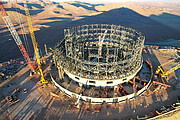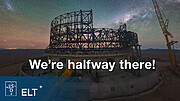Persbericht
ESO's Extremely Large Telescope is nu half af
11 juli 2023
De Extremely Large Telescope (ELT) van de Europese Zuidelijke Sterrenwacht (ESO) is een revolutionaire aardse telescoop met een hoofdspiegel van 39 meter. Het wordt de grootste telescoop ter wereld voor zichtbaar en infrarood licht: 's werelds grootste oog op de hemel. De bouw van dit technisch complexe project verloopt in een vlot tempo. De ELT is nu de mijlpaal van 50% voltooiing gepasseerd.
De telescoop bevindt zich bovenop Cerro Armazones in de Chileense Atacama-woestijn. Ingenieurs en bouwvakkers zijn bezig om de structuur van de telescoopkoepel in een snel tempo in elkaar te zetten. De stalen constructie, die elke dag verandert, krijgt snel de typische kenmerkend ronde vorm voor telescoopkoepels.
De spiegels en andere onderdelen van de telescoop worden gebouwd door bedrijven in Europa, waar de werkzaamheden ook voorspoedig verlopen. ESO's ELT krijgt een baanbrekend optisch ontwerp met vijf spiegels, waaronder een reusachtige hoofdspiegel (M1) die bestaat uit 798 zeshoekige segmenten. Meer dan 70% van de onderdelen en steunen voor deze segmenten zijn nu gemaakt. Ondertussen zijn M2 en M3 gegoten en worden ze gepolijst. De vooruitgang aan M4, een adaptieve, flexibele spiegel die zijn vorm duizend keer per seconde aanpast om vervormingen veroorzaakt door luchtturbulentie te corrigeren, is indrukwekkend. Alle zes dunne bloemblad-achtige segmenten zijn klaar en kunnen worden ingebouwd in het geheel. Daarnaast zijn de zes laserbronnen, een ander belangrijk onderdeel van de adaptieve optiek van de ELT, geproduceerd en geleverd aan ESO voor tests.
De andere systemen van de ELT, waaronder het besturingssysteem en de apparatuur om de telescoop te bouwen en in bedrijf te stellen, boeken ook vooruitgang. Daarnaast bevinden alle vier de eerste wetenschappelijke instrumenten zich in de laatste ontwerpfase. Bovendien is het grootste deel van de ondersteunende infrastructuur voor de ELT nu aanwezig op of bij Cerro Armazones. Zo is het technische gebouw dat onder andere gebruikt zal worden voor de opslag en het coaten van verschillende ELT-spiegels volledig ingericht. Daarnaast is de fotovoltaïsche installatie die de ELT-locatie van hernieuwbare energie voorziet, vorig jaar in gebruik genomen.
De bouw van ESO's ELT ging negen jaar geleden van start met een openingsceremonie waarbij de top van Cerro Armazones werd afgevlakt om ruimte te maken voor de reuzentelescoop.
De voltooiing van de resterende 50% van het project zal naar verwachting aanzienlijk sneller gaan dan de bouw van de eerste helft van de ELT. De eerste helft van het project omvatte het langdurige en nauwgezette proces van het definitief maken van het ontwerp van de overgrote meerderheid van de onderdelen die voor de ELT moesten worden gefabriceerd. Daarnaast moesten sommige onderdelen, zoals de spiegelsegmenten en de ondersteunende componenten en sensoren, eerst in detail worden getest voordat ze in serie konden worden geproduceerd.
Bovendien werd de bouw beïnvloed door de COVID-19-pandemie, waardoor de bouwlocatie enkele maanden gesloten was en de productie van veel telescooponderdelen vertraging opliep. Nu de productieprocessen zijn hervat en gestroomlijnd, zal de voltooiing van de resterende helft van de ELT naar verwachting slechts vijf jaar in beslag nemen. Toch is het bouwen van zo'n grote en complexe telescoop als de ELT niet vrij van risico's totdat hij echt helemaal klaar is en werkt.
ESO-directeur-generaal Xavier Barcons: "De ELT is de grootste van de nieuwe generatie optische en nabij-infraroodtelescopen op aarde en degene waarvan de bouw het verst gevorderd is. Het bereiken van 50% oplevering is geen geringe prestatie, gelet op de uitdagingen die eigen zijn aan grote, complexe projecten. Het was alleen mogelijk dankzij de inzet van iedereen bij ESO, de voortdurende steun van de ESO-lidstaten en de betrokkenheid van onze partners in de industrie en instrumentconsortia. Ik ben ontzettend trots dat de ELT deze mijlpaal heeft bereikt."
De ELT van de ESO zal volgens de planning in 2028 beginnen met wetenschappelijke waarnemingen. Vragen die astronomen willen beantwoorden, zijn bijvoorbeeld: Zijn wij alleen in het heelal? Zijn de natuurwetten universeel? Hoe ontstonden de eerste sterren en sterrenstelsels? Het onderzoek zal de kennis over het heelal drastisch veranderen en ons anders laten nadenken over onze plaats in de kosmos.
Noten
Het voltooiingspercentage van ELT wordt geschat op basis van de zogeheten 'earned value', een maat die projectmanagement gebruikt om de voortgang van een project te bepalen waarbij rekening wordt gehouden met planning en kosten. Op dit moment bevindt de ELT zich op 50% van het projectplan.
Meer informatie
De Europese Zuidelijke Sterrenwacht (ESO) stelt wetenschappers van over de hele wereld in staat om de geheimen van het heelal te ontdekken, ten bate van iedereen. Wij ontwerpen, bouwen en exploiteren observatoria van wereldklasse die door astronomen worden gebruikt om spannende vragen te beantwoorden en de fascinatie voor astronomie te verspreiden, en bevorderen internationale samenwerking op het gebied van de astronomie. ESO, in 1962 opgericht als intergouvernementele organisatie, wordt inmiddels gedragen door 16 lidstaten (België, Denemarken, Duitsland, Finland, Frankrijk, Ierland, Italië, Nederland, Oostenrijk, Polen, Portugal, Spanje, Tsjechië, het Verenigd Koninkrijk, Zweden en Zwitserland) en door het gastland Chili, met Australië als strategische partner. Het hoofdkwartier van de ESO en haar bezoekerscentrum en planetarium, de ESO Supernova, zijn gevestigd nabij München in Duitsland, maar onze telescopen staan opgesteld in de Chileense Atacama-woestijn – een prachtige plek met unieke omstandigheden voor het doen van hemelwaarnemingen. ESO exploiteert drie waarnemingslocaties: La Silla, Paranal en Chajnantor. Op Paranal staan ESO’s Very Large Telescope en Very Large Telescope Interferometer, evenals surveytelescopen zoals VISTA. Ook zal ESO op Paranal de Cherenkov Telescope Array South huisvesten en exploiteren – ’s werelds grootste en gevoeligste observatorium van gammastraling. Samen met internationale partners beheert ESO APEX en ALMA op Chajnantor, twee faciliteiten die de hemel waarnemen in het millimeter- en submillimetergebied. Op Cerro Armazones, nabij Paranal, bouwen wij ‘het grootste oog ter wereld’ – ESO’s Extremely Large Telescope. Vanuit onze kantoren in Santiago, Chili, ondersteunen wij onze activiteiten in het gastland en werken wij samen met Chileense partners en de Chileense samenleving.
Links
Contact
Bárbara Ferreira
ESO Media Manager
Garching bei München, Germany
Tel: +49 89 3200 6670
Mobiel: +49 151 241 664 00
E-mail: press@eso.org
Marieke Baan (Perscontact Nederland)
ESO Science Outreach Network
en NOVA Informatie Centrum
Tel: +31(0)20-5257480
E-mail: eson-netherlands@eso.org
Over dit bericht
| Persberichten nr.: | eso2310nl |
| Naam: | Extremely Large Telescope |
| Type: | Unspecified : Technology : Observatory |
| Facility: | Extremely Large Telescope |
Our use of Cookies
We use cookies that are essential for accessing our websites and using our services. We also use cookies to analyse, measure and improve our websites’ performance, to enable content sharing via social media and to display media content hosted on third-party platforms.
ESO Cookies Policy
The European Organisation for Astronomical Research in the Southern Hemisphere (ESO) is the pre-eminent intergovernmental science and technology organisation in astronomy. It carries out an ambitious programme focused on the design, construction and operation of powerful ground-based observing facilities for astronomy.
This Cookies Policy is intended to provide clarity by outlining the cookies used on the ESO public websites, their functions, the options you have for controlling them, and the ways you can contact us for additional details.
What are cookies?
Cookies are small pieces of data stored on your device by websites you visit. They serve various purposes, such as remembering login credentials and preferences and enhance your browsing experience.
Categories of cookies we use
Essential cookies (always active): These cookies are strictly necessary for the proper functioning of our website. Without these cookies, the website cannot operate correctly, and certain services, such as logging in or accessing secure areas, may not be available; because they are essential for the website’s operation, they cannot be disabled.
Functional Cookies: These cookies enhance your browsing experience by enabling additional features and personalization, such as remembering your preferences and settings. While not strictly necessary for the website to function, they improve usability and convenience; these cookies are only placed if you provide your consent.
Analytics cookies: These cookies collect information about how visitors interact with our website, such as which pages are visited most often and how users navigate the site. This data helps us improve website performance, optimize content, and enhance the user experience; these cookies are only placed if you provide your consent. We use the following analytics cookies.
Matomo Cookies:
This website uses Matomo (formerly Piwik), an open source software which enables the statistical analysis of website visits. Matomo uses cookies (text files) which are saved on your computer and which allow us to analyze how you use our website. The website user information generated by the cookies will only be saved on the servers of our IT Department. We use this information to analyze www.eso.org visits and to prepare reports on website activities. These data will not be disclosed to third parties.
On behalf of ESO, Matomo will use this information for the purpose of evaluating your use of the website, compiling reports on website activity and providing other services relating to website activity and internet usage.
Matomo cookies settings:
Additional Third-party cookies on ESO websites: some of our pages display content from external providers, e.g. YouTube.
Such third-party services are outside of ESO control and may, at any time, change their terms of service, use of cookies, etc.
YouTube: Some videos on the ESO website are embedded from ESO’s official YouTube channel. We have enabled YouTube’s privacy-enhanced mode, meaning that no cookies are set unless the user actively clicks on the video to play it. Additionally, in this mode, YouTube does not store any personally identifiable cookie data for embedded video playbacks. For more details, please refer to YouTube’s embedding videos information page.
Cookies can also be classified based on the following elements.
Regarding the domain, there are:
- First-party cookies, set by the website you are currently visiting. They are stored by the same domain that you are browsing and are used to enhance your experience on that site;
- Third-party cookies, set by a domain other than the one you are currently visiting.
As for their duration, cookies can be:
- Browser-session cookies, which are deleted when the user closes the browser;
- Stored cookies, which stay on the user's device for a predetermined period of time.
How to manage cookies
Cookie settings: You can modify your cookie choices for the ESO webpages at any time by clicking on the link Cookie settings at the bottom of any page.
In your browser: If you wish to delete cookies or instruct your browser to delete or block cookies by default, please visit the help pages of your browser:
Please be aware that if you delete or decline cookies, certain functionalities of our website may be not be available and your browsing experience may be affected.
You can set most browsers to prevent any cookies being placed on your device, but you may then have to manually adjust some preferences every time you visit a site/page. And some services and functionalities may not work properly at all (e.g. profile logging-in, shop check out).
Updates to the ESO Cookies Policy
The ESO Cookies Policy may be subject to future updates, which will be made available on this page.
Additional information
For any queries related to cookies, please contact: pdprATesoDOTorg.
As ESO public webpages are managed by our Department of Communication, your questions will be dealt with the support of the said Department.




